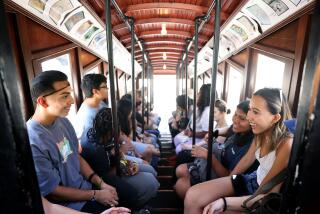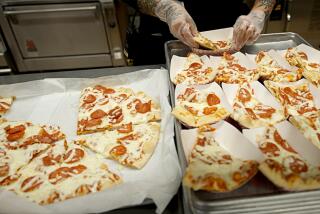FOUNTAIN VALLEY : Students ‘Eat Up’ Cultural Diversity
Student Mike Motschman, 12, baked baklava, a pastry dessert of Greece, to offer his classmates. Others brought samples of kutsinta, or rice cake, from the Philippines, pineapple from Hawaii, sushi balls, a native food of Japan, and lakrids, black licorice candy from Denmark.
At Masuda Middle School on Wednesday, students celebrated their cultural diversity with a fair of food, music and costume. The second annual Cultural Faire was held to give the student body a better appreciation of the world community that the school represents, school officials said.
Some wore their native dress, such as a kimono from Japan, or a barong Tagalog , an embroidered dress shirt worn by men in the Philippines. And they arrived with fried bananas with lemon and sugar, a treat of Jamaica, enchiladas of Mexico or Taiwan beef dumplings.
“This is living social studies,” said Lorraine Leavitt, Masuda’s school principal. “You can study about Taiwan or Ireland in a book, but this is an experience of touching, tasting and feeling these countries.”
Leavitt said 17 languages and 25 countries are represented at the school.
The school itself is named after Kazuo Masuda of Fountain Valley, who was killed during World War II while his family was held at an internment camp in California. Teacher Pam Burris said that a Japanese garden and memorial for Masuda at the school is a daily reminder to students of the need for multicultural understanding and acceptance. Because the Cultural Faire was such a hit last year, the number of booths this year nearly doubled to 29, Burris said.
Students, their mothers, grandmothers and aunts helped cook ethnic foods, and the school’s student council paid $15 toward the cost of food for each booth.
Renata Hofmanova,14, who arrived in this country eight months ago from Czechoslovakia, brought buchta s broskvama, which she described as a pie with peaches traditionally eaten on Sundays after church and on holidays.
“It’s fun. I like it so I can show everybody what my country looks like,” said Hofmanova, who made a display of pictures from her homeland, native birthday cards and school books.
Classmate Hanieh Azar,11, who is Iranian, helped Hofmanova in her booth because she wanted to learn more about her friend’s culture.
“I learned a lot of things about her country--and now I understand her better,” Azar said.
As the only Masuda student from Laos, Phoulivong Soukphilanouvong, 11, proudly stood by his country’s display and offered his classmates samples of dried meat and cooked pumpkin wedges with egg, coconut, sugar and butter.
“I’ve had a chance to show everybody what kind of food we eat and let them know what Laos is all about,” he said.
Phoulivong, who came to the United States three years ago to live with his aunt, leaving his immediate family behind, said he likes to tell other students about his native country.
“Because when they know about my country, we can talk about it and be friends,” he said.
Principal Don Keller said the multicultural event gives students a chance to work together, and through classroom curriculum, they learn about world geography and history.
“The real prize of having this is that the students get a sense of identity and pride in their heritage,” Keller said.
More to Read
Sign up for Essential California
The most important California stories and recommendations in your inbox every morning.
You may occasionally receive promotional content from the Los Angeles Times.










